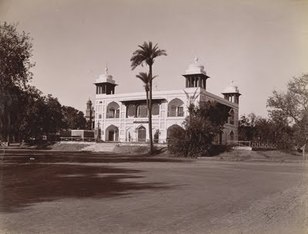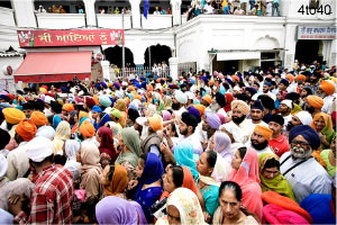With a literacy rate of 73 percent, Chakwal is the second-most literate district in Punjab, after Rawalpindi, with its literacy rate of 75 percent. Pakistan’s literacy rate, which is said to be 57 percent today, was 11 percent at the time of Partition. It was probably less than one percent back in 1910. On Oct 17, that year, Harbans Singh Seestani, one of the five top students of Munshi Sardar Sant Singh, laid the foundation stone of Sant Singh Khalsa School in Chakwal.
In 1949, a degree college was established in the building of the town’s Government High School. Rather than moving the high school to another building, the authorities thought it more convenient to merge it with Sant Singh Khalsa School. In the process the historical institution lost its original name and went by the name of the school that had been merged with it, Government High School, Chakwal.
In 1992, the institution was to undergo another name change. After a Government High School No 2 was established in Chakwal that year, the first school merely became School No 1. The degraded name is symbolic of one fact, though: that it is, as it had always been, the number-one school of Chakwal district.
However, rather than go out of existence the original name of Sant Singh Khalsa School resurfaced in New Delhi. There is a Sant Singh Khalsa School Chakwal Senior Secondary School in the Indian capital’s area of Lajpat Nagar. It is built on 40 kanals, or more than 70 acres, allotted by the Indian government after the five devoted students of Munshi Sardar Sant Singh filed a claim for compensation for the schoolhouse they had left behind in Pakistan.
When School No 1 in Chakwal held a ceremony last Oct 17 in celebration of the centenary of Sant Singh Khalsa School, a grandson of Sardar Harbans Singh Seestani, its founder, was the chief guest. Sardar Lakhandar Singh Bahal is a retired air vice marshal of the Indian air force.
The ceremony was held in the main hall of the school, with its high ceiling, which was a hallmark of the fine architecture of that time and which lent stateliness to the memorable occasion.
The other invitees included a number of former students and teachers of the beloved old school, both Indian and Pakistani. Retired general Abdul Majeed Malik, a former federal minister, and the director general of the Rangers, Maj Gen Mohammad Yaqub, were among the latter group.
There were tears in his eyes when Sardar Lakhandar Singh Bahal read out the inscription on the school’s original plaque in the Gurmukhi script, in which Punjabi is still written in India.
Ratan Deep Singh Kohli, who is chairman of Sant Singh Khalsa School Chakwal Senior Secondary School, said his speech: “The name of Chakwal will always live in India. The people of Chakwal hold a special place in the hearts of the thousands of students who enter and have entered the gate of the building of Sant Singh Khalsa School Khalsa Secondary School in New Delhi.” (The headmaster of the original school in Chakwal is Dr Mohammad Abid Hussain Kiyani.)
Beginning his speech with the recitation of “Bismillah-ir-Rehman-ir-Raheem,” he expressed his sympathies with those who had been killed in Pakistan’s devastating floods of July and August in 2010, and with the victims of the wars of 1965 and 1971.
The speaker related this incident about the great Sufi saint Khwaja Nizamuddin Aulia (1238-1325), of whom the most famous disciple was Hazrat Amir Khusrau (b. 1253), who died the same year as his patron.
A Hindu temple near the home of Hazrat Nizamuddin Aulia stopped ringing its bells so that the sound will not disturb the revered figure in his prayers. After a few days, the saint enquired why the bells of the temple did not ring anymore. On being told the reason by Hazrat Amir Khusrau, Hazrat Nizamuddin Aulia responded with these words: “For ye your own faith; for me, mine.” The great man asked that the bells must go on ringing.
Happily, so many institutions retain their old names in our different cities and towns, including Gulab Daiwi Hospital, Sir Ganga Ram Hospital, Dayal Singh College, Gordon College, Holy Family Hospital, and King Edward Medical College. Then there is the town of Toba Tek Singh, whose residents strongly opposed the proposal for its name to be changed. In Sindh, the residents of Jacobabad (named after Brig Gen Sir John Jacob of the East India Company, who enjoys enduring admiration for his services to the people of the area and has a mausoleum there) similarly opposed the renaming of the city to Khangarh. Among the many Hindu and Sikh place-names in Karachi are Ramswami, Bhempura, Gurumandar and Nanakwara. The city of Chakwal itself has an area named Kot Ganesh Singh, just as Rawalpindi has an area called Mukha Singh State.
Therefore there is no reason why School No 1 should not revert to its original name of Sant Singh Khalsa School Chakwal, and upgraded to higher secondary level.
That would be the finest tribute the people of Chakwal can pay to a great benefactor, Munshi Sardar Sant Singh and the best way of repaying their debt of gratitude to him.
In 1949, a degree college was established in the building of the town’s Government High School. Rather than moving the high school to another building, the authorities thought it more convenient to merge it with Sant Singh Khalsa School. In the process the historical institution lost its original name and went by the name of the school that had been merged with it, Government High School, Chakwal.
In 1992, the institution was to undergo another name change. After a Government High School No 2 was established in Chakwal that year, the first school merely became School No 1. The degraded name is symbolic of one fact, though: that it is, as it had always been, the number-one school of Chakwal district.
However, rather than go out of existence the original name of Sant Singh Khalsa School resurfaced in New Delhi. There is a Sant Singh Khalsa School Chakwal Senior Secondary School in the Indian capital’s area of Lajpat Nagar. It is built on 40 kanals, or more than 70 acres, allotted by the Indian government after the five devoted students of Munshi Sardar Sant Singh filed a claim for compensation for the schoolhouse they had left behind in Pakistan.
When School No 1 in Chakwal held a ceremony last Oct 17 in celebration of the centenary of Sant Singh Khalsa School, a grandson of Sardar Harbans Singh Seestani, its founder, was the chief guest. Sardar Lakhandar Singh Bahal is a retired air vice marshal of the Indian air force.
The ceremony was held in the main hall of the school, with its high ceiling, which was a hallmark of the fine architecture of that time and which lent stateliness to the memorable occasion.
The other invitees included a number of former students and teachers of the beloved old school, both Indian and Pakistani. Retired general Abdul Majeed Malik, a former federal minister, and the director general of the Rangers, Maj Gen Mohammad Yaqub, were among the latter group.
There were tears in his eyes when Sardar Lakhandar Singh Bahal read out the inscription on the school’s original plaque in the Gurmukhi script, in which Punjabi is still written in India.
Ratan Deep Singh Kohli, who is chairman of Sant Singh Khalsa School Chakwal Senior Secondary School, said his speech: “The name of Chakwal will always live in India. The people of Chakwal hold a special place in the hearts of the thousands of students who enter and have entered the gate of the building of Sant Singh Khalsa School Khalsa Secondary School in New Delhi.” (The headmaster of the original school in Chakwal is Dr Mohammad Abid Hussain Kiyani.)
Beginning his speech with the recitation of “Bismillah-ir-Rehman-ir-Raheem,” he expressed his sympathies with those who had been killed in Pakistan’s devastating floods of July and August in 2010, and with the victims of the wars of 1965 and 1971.
The speaker related this incident about the great Sufi saint Khwaja Nizamuddin Aulia (1238-1325), of whom the most famous disciple was Hazrat Amir Khusrau (b. 1253), who died the same year as his patron.
A Hindu temple near the home of Hazrat Nizamuddin Aulia stopped ringing its bells so that the sound will not disturb the revered figure in his prayers. After a few days, the saint enquired why the bells of the temple did not ring anymore. On being told the reason by Hazrat Amir Khusrau, Hazrat Nizamuddin Aulia responded with these words: “For ye your own faith; for me, mine.” The great man asked that the bells must go on ringing.
Happily, so many institutions retain their old names in our different cities and towns, including Gulab Daiwi Hospital, Sir Ganga Ram Hospital, Dayal Singh College, Gordon College, Holy Family Hospital, and King Edward Medical College. Then there is the town of Toba Tek Singh, whose residents strongly opposed the proposal for its name to be changed. In Sindh, the residents of Jacobabad (named after Brig Gen Sir John Jacob of the East India Company, who enjoys enduring admiration for his services to the people of the area and has a mausoleum there) similarly opposed the renaming of the city to Khangarh. Among the many Hindu and Sikh place-names in Karachi are Ramswami, Bhempura, Gurumandar and Nanakwara. The city of Chakwal itself has an area named Kot Ganesh Singh, just as Rawalpindi has an area called Mukha Singh State.
Therefore there is no reason why School No 1 should not revert to its original name of Sant Singh Khalsa School Chakwal, and upgraded to higher secondary level.
That would be the finest tribute the people of Chakwal can pay to a great benefactor, Munshi Sardar Sant Singh and the best way of repaying their debt of gratitude to him.



 RSS Feed
RSS Feed